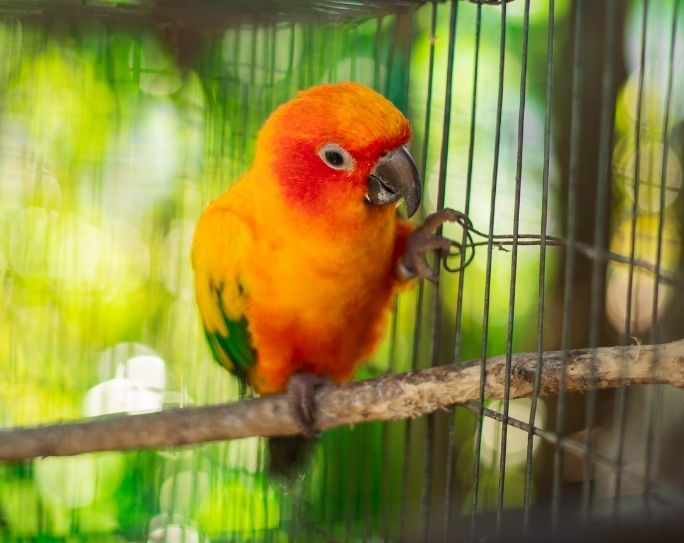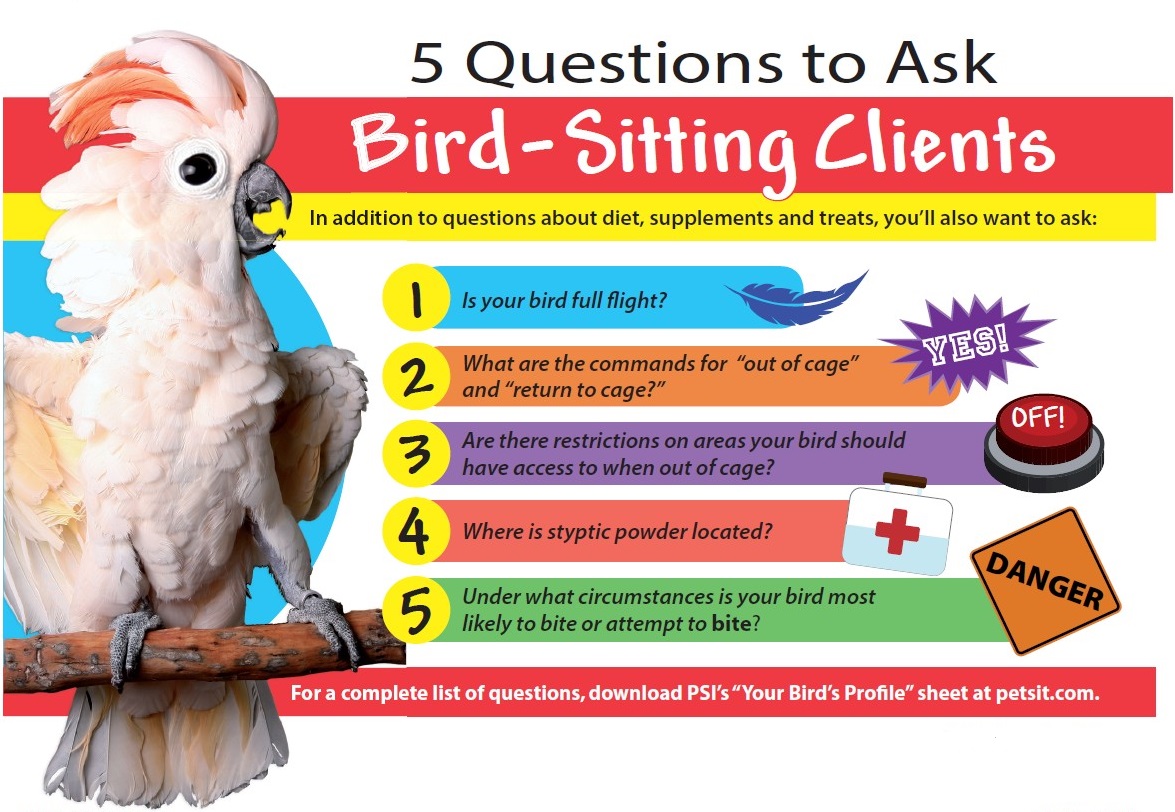Bird-sitting basics for professional pet sitters
Data provided in the 2017-2018 APPA National Pet Owners Survey indicates there are 7.9 million households with pet birds (and 20.3 million birds) in the U.S. alone. According to PSI’s latest State of the Industry Survey, 78 percent of PSI member pet sitters indicated offering pet-sitting services for birds.
For these professional pet sitters—and others who are considering offering bird-sitting services—an understanding of best bird-care practices is important to ensure that both the bird and pet sitter remain safe during pet-sitting visits.

Ask the right questions.
When preparing to introduce yourself to a client’s pet bird, there are some questions that you should ask before you arrive:
- Is the bird permitted free flight through the home? If so, ask that the bird be caged during your meeting to prevent him from flying out when you enter and also to give you a chance to interact with the bird in a more controlled environment.
- Are there treats that the bird particularly enjoys and if so, do you have permission to bring one or two? Treats are an easy way to establish your intentions with the bird and show her that you are friendly.
- Does the bird know the command for ‘up’? This command is used by bird owners to train their birds to perch on their hand and makes removing the bird from the cage easier.
- When was the last time your bird bit someone? By asking the question this way, the bird owner may be inclined to be more forthcoming than if you had asked a yes or no question.
Keep these best practices in mind while bird sitting.
- Once you are in the home and interacting with the bird, keep your voice low and calm. Birds will vocalize to match their environment, so if you are loud and noisy, the bird will likely mimic the behavior. Some bird species use vocalizations in the wild to communicate danger, which is not the first impression you want to make.
- Do not place your fingers through the bars of the cage! You are unfamiliar to the bird at this point and as such, even the friendliest bird may be tempted to bite you for encroaching on her territory. Talk to the bird and monitor her reaction to you. If the bird appears relaxed, with no shaking or growling, follow the bird owner’s lead and ask if it is acceptable for you to give treats. If the bird is not comfortable with hand-feeding, place the treats in their usual food bowl.
- Keep in mind that some birds may have bonded to one person exclusively, which means the bird very likely will not like you or appreciate being handled by you. You should not take this personally and explain to the pet owner that for the bird’s comfort and your safety, you will limit your visits to refreshing food and water, tidying up the cage, and just talking or reading to the bird for the remainder of your visit.
- If the bird is accustomed to having free flight time in the home, you will need to determine your comfort level with allowing this during your visits. A bird may return to his cage perfectly for his owner, but be much more reluctant to do the same for you. Birds are also very inquisitive by nature and that coupled with a delicate frame can make the household a dangerous place for a bird to roam free. For the safety and well-being of the bird, it may be in your best interests to leave the bird in his cage and leave free flight time to his owner.
- When caring for the bird, you should first secure the room. Birds are very clever and opportunistic, so any time you open the cage door is a chance that the bird could fly out. Securing the room beforehand limits the danger of household items and the risk of losing the bird. Secure and lock all windows, shut all doors, make sure that any other pets are in another room, unplug electronics and turn off any fans. You should also consider having some high value treats in the room with you so that you can use them to lure the bird back to her cage.
- Ask the bird’s owner to set up the cage so that you can remove food and water bowls, as well as clean toys and the bottom of the cage without removing or disturbing the bird. By having the cage set up this way in advance, you will be able to provide the best possible care to the bird regardless of its temperament in general or feelings towards you in particular.
- After caring for a pet bird, it is important that you wash your hands in warm, soapy water and change your clothes. Infections can spread quickly between birds and these are steps you can take to prevent contaminating another household.
Additional Resources:
- PSI’s Bird-Care Profile Sheet
- The Cornell Lab Bird Academy article “Everything You Need to Know About Feathers”
- Association of Avian Veterinarians article “Basic Pet Bird Care”
- Drs. Foster and Smith article “Understanding Bird Body Language: What Your Parrot or Other Bird is Trying to Tell You”








Comments
birdsitting
birdsitting
Thank you for sharing your expertise!
Best regards,
Lily Gernert
Latoya Scandrick
Magdalena
Angela Cupp
Omar Guerrero
Thanks
jbcrittersitters
Michelle Boden
Also, probably the most important thing to know about bird care is how to put them back in their cage without harming them.
Clare Mix, Wings and Whiskers Pet Sitting
1) Feathers grow with a vein inside filled with blood. If a "blood feather" breaks, it can keep bleeding without stopping and kill the bird. It is very important that either the pet sitter know how to pull out one of these feathers with a plier or take the bird to a vet asap.
2) Certain foods are extremely toxic to birds that the sitter should know about. And different species have different needs. Some are seed eaters while others are veggie or fruit eaters or nectar eaters.
3) If a bird does bite you, DON'T REACT. They will learn that this worked and may bite again.
4) Birds are extremely empathetic. They pick up on your emotional vibes. Keep calm and think happy thoughts!
I hope some of these tips help! Birds are amazing creatures!
Kim Dawson
Beth Brown